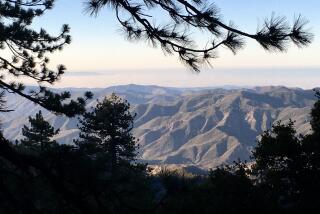Plan Gets Static From KWAVE
- Share via
The U.S. Forest Service is exploring a plan to ban commercial broadcasting from transmitters on Santiago Peak in the Cleveland National Forest, a move that could force San Clemente-based KWAVE to tear down its newly installed radio antenna.
Forestry officials say that the powerful commercial broadcasts could interfere with the peak’s weaker two-way radio transmitters, which are used by most of the county’s police, fire and emergency departments. Strong emissions might also drive away native animals in the forest, particularly bats, whose ultrasonic hearing may be affected by the antennas, biologists said.
But without the antenna on Santiago Peak, officials for KWAVE said, the Christian talk and music station would no longer reach most of its inland audience. Thousands of KWAVE listeners have flooded the U.S. Forest Service with letters demanding that the antenna stay on Santiago Peak.
KWAVE, owned by Calvary Chapel in Costa Mesa, broadcasts from north San Diego County through Orange County to south Los Angeles County and into the Inland Empire. Station officials say it has been rated the No. 1 Christian station in the country, but they would not release any numbers on listeners.
The proposal to ban broadcasts from Santiago Peak could affect radio and television stations across Southern California, which would lose potential access to prime broadcasting space on the 5,700-foot-tall peak.
It was just that possibility of more broadcasters requesting space on the peak that drove the U.S. Forest Service to consider the ban, said Mary Thomas, project leader for the Trabuco Ranger District, which oversees Santiago Peak.
Although KWAVE is the only commercial station currently on the peak, officials fear that more broadcasters will seek to install antennas there. The forest does not have a formal policy on electronic broadcasts from the site.
An environmental analysis to determine interference levels with law-enforcement radio signals and animal life is due in November. Forest officials will review that analysis before making a final decision on whether to ban commercial broadcasts.
Officials for KWAVE said there is no evidence that commercial broadcasting disturbs emergency transmissions or wildlife. Tests conducted one day earlier this year found no proof of interference, the U.S. Forest Service’s Thomas confirmed.
Instead, radio station officials said, the move to ban commercial broadcasting from Santiago Peak seems to be a direct attack on KWAVE, which won the right to broadcast from the peak after a lengthy court battle that ended this summer. The station began broadcasting from Santiago Peak in July.
“I feel it’s an attempt to circumvent the judge’s ruling,” said Robert Cadman, the station’s general manager.
Thomas denied the charge. The KWAVE case merely brought to the U.S. Forest Service’s attention the need for a formal policy that deals with electronic media on Santiago Peak, she said. The agency is considering whether to allow commercial broadcasts from nearby Modjeska Peak, which is slightly lower than Santiago. But if serious damage to wildlife is found, that may not happen either.
Although a final decision on the ban is months away, faithful KWAVE listeners have inundated the U.S. Forest Service with letters imploring that the antenna remain on the peak.
“For Orange County, it’s been a mainstay of Bible teaching,” said Brian Brodersen, an associate pastor at Calvary Chapel who hosts the “Back to Basics” radio program.
But the letters could have little impact on the ultimate decision, if it is discovered that radio transmissions do affect emergency radio signals or wildlife, Thomas said.
“They’re a small piece of the picture but not necessarily the whole picture,” she said.
(BEGIN TEXT OF INFOBOX / INFOGRAPHIC)
Making Waves
A possible ban on commercial broadcasting from the mountaintop is opposed by a San Clemente-based Christian station.
More to Read
Sign up for Essential California
The most important California stories and recommendations in your inbox every morning.
You may occasionally receive promotional content from the Los Angeles Times.













